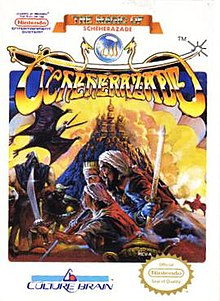| The Magic of Scheherazade | |
|---|---|
 North American cover art | |
| Developer(s) | Culture Brain |
| Publisher(s) | Culture Brain |
| Producer(s) | Akademiya Yumenosuke[3] |
| Composer(s) | Akinori Sawa[4] Shunichi Mikame[5] |
| Platform(s) | Nintendo Entertainment System |
| Release | |
| Genre(s) | Action-adventure Role-playing |
| Mode(s) | Single-player |
The Magic of Scheherazade[a] is an action-adventure/role-playing video game (RPG) developed and released by Culture Brain for the Nintendo Entertainment System (NES). The game was released in 1987 in Japan and 1990 in North America. The plot is based on Middle Eastern folktales found in One Thousand and One Nights. It involves an amnesic hero traveling through time in an attempt to rescue the princess Scheherazade from the evil wizard Sabaron, who has summoned a horde of demons to bring chaos to the once peaceful land of Arabia. The Magic of Scheherazade is divided into chapters and incorporates elements of both action-adventure and RPG gameplay styles. In each chapter, the player character can freely explore an overworld in a top-down perspective. The player engages hostile enemies with various weapons and spells through both real-time solo action on the overhead map and random, turn-based battles fought alongside befriended allies.
Once the commercial viability of the NES was proven in North America by the late 1980s, Japanese developer Culture Brain opened a company branch in the United States and chose to publish an English-language version of The Magic of Scheherazade after making several changes to the graphics and musical score. It has received mostly average review scores but generally positive commentary from critics for its visuals, gameplay, and difficulty balance. The game has been noted for its fusion of the adventure and RPG genres, though journalists have referred to its gameplay mechanics as lower-quality versions of what was seen in both The Legend of Zelda and the Dragon Quest series.
- ^ Famitsu staff (August 7–21, 1987). "クロスレビュー" [Cross Review]. Shukan Famicom Tsushin (in Japanese). No. 16/17. ASCII Corporation. p. 12. Archived from the original on March 31, 2019. Retrieved March 16, 2019.
- ^ Harris, Steve; Semrad, Ed; Alessi, Martin; and Williams, Ken (January 1990). "Electronic Gaming Review Crew: Sharazade [sic]". Electronic Gaming Monthly. No. 6. Sendai Publishing. p. 10. ISSN 1058-918X.
{{cite magazine}}: CS1 maint: multiple names: authors list (link) - ^ Famitsu staff (December 17, 1993). "DREAM TALK". Weekly Famitsu (in Japanese). No. 261. ASCII Corporation.
- ^ Sawa Akinori (2000). "Profile" (in Japanese). Archived from the original on December 2, 2008. Retrieved March 16, 2019.
- ^ Mikame Shunichi (1997). "Profile". IPV4 Security. Archived from the original on November 4, 2015. Retrieved March 24, 2019.
Cite error: There are <ref group=lower-alpha> tags or {{efn}} templates on this page, but the references will not show without a {{reflist|group=lower-alpha}} template or {{notelist}} template (see the help page).